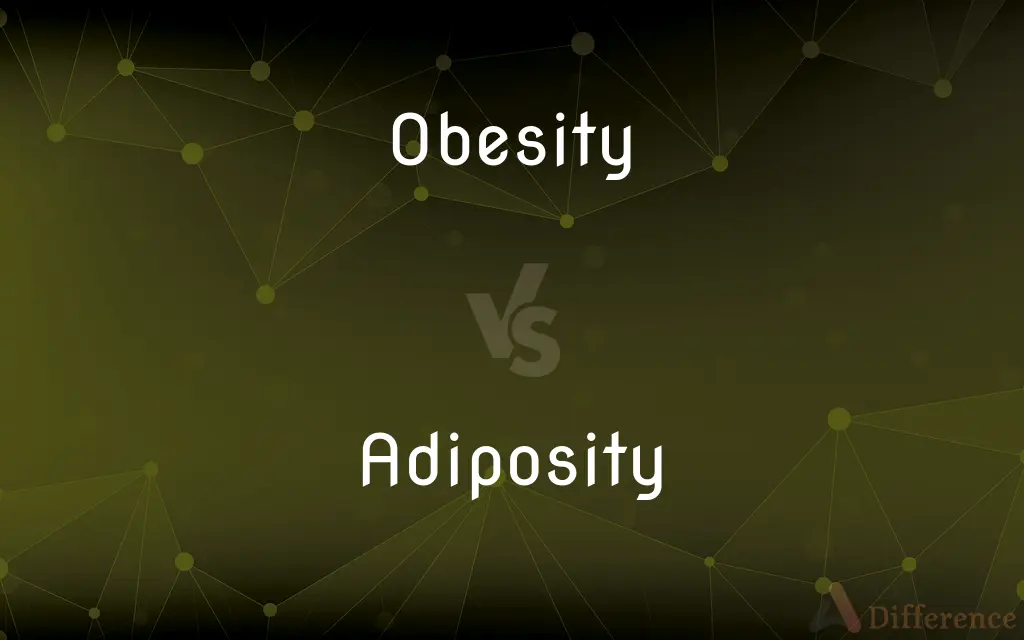Obesity vs. Adiposity — What's the Difference?
By Urooj Arif & Fiza Rafique — Updated on March 3, 2024
Obesity is a medical condition characterized by excessive body fat accumulation that poses health risks, while adiposity refers to the presence of body fat or fat tissue in the body, regardless of its amount or health impact.

Difference Between Obesity and Adiposity
Table of Contents
ADVERTISEMENT
Key Differences
Obesity is defined by specific criteria that often include body mass index (BMI) thresholds (a BMI of 30 or higher is typically considered obese). It is recognized as a health condition that can lead to serious diseases, such as type 2 diabetes, heart disease, and certain cancers. Adiposity, on the other hand, is a broader term that describes the presence of fat tissue in the body. It can be measured in various ways, including BMI, waist circumference, and more precise methods like dual-energy X-ray absorptiometry (DXA). Adiposity itself is not inherently negative, as body fat plays essential roles in energy storage, hormone production, and protection of internal organs.
Obesity results from a combination of factors, including genetics, lifestyle choices, diet, and physical activity levels, and it is considered a major public health issue globally. The focus on obesity often includes both prevention and management strategies, aimed at reducing the health risks associated with excessive fat accumulation. However, the distribution and amount of adipose tissue can significantly impact health, with central adiposity (fat stored around the abdomen) being particularly associated with metabolic risks.
While obesity is a condition that implies an excess amount of body fat that affects health, adiposity is a neutral term that simply refers to the body's fat content. The assessment of adiposity can provide insights into an individual's risk for obesity-related health conditions, but not all individuals with high adiposity levels are considered obese, particularly if the fat distribution does not lead to health complications.
The distinction between these two terms highlights the complexity of body fat and its impact on health. Obesity is a specific, clinically relevant condition with clear health implications, while adiposity is a more general term that acknowledges the role of body fat without directly linking it to health outcomes. Understanding this distinction is important for health professionals in diagnosing, treating, and advising individuals on their health and lifestyle choices.
Both obesity and adiposity are influenced by a complex interplay of genetic, environmental, and lifestyle factors. Addressing them involves a holistic approach that includes dietary changes, increased physical activity, and sometimes medical interventions. Public health efforts aim to reduce the prevalence of obesity and associated health risks through education, policy changes, and community support initiatives.
ADVERTISEMENT
All obese individuals have high adiposity, not all individuals with high adiposity are considered obese. The assessment and understanding of each require different approaches, reflecting the nuanced relationship between body fat and health.
Comparison Chart
Definition
Excessive fat accumulation posing health risks
Presence of body fat or fat tissue
Measurement
Body mass index (BMI), waist circumference
BMI, waist circumference, DXA, bioelectrical impedance
Health Implications
Associated with diseases like diabetes, heart disease
Can indicate risk for health issues, but not inherently negative
Focus
Health condition requiring management
Neutral term describing body fat composition
Public Health
Major concern, targeted by prevention and management strategies
Assessed for insights into health risks
Fat Distribution
General excess, particularly concerning when central
Includes all body fat, with distribution important for risk assessment
Interventions
Lifestyle changes, dietary modifications, medical treatment
Depends on the level and health impact of fat
Perception
Often viewed negatively due to health risks
Viewed more neutrally, focusing on fat's biological roles
Compare with Definitions
Obesity
A condition marked by excessive body fat affecting health.
Obesity increases the risk of developing type 2 diabetes.
Adiposity
The presence of body fat or fat tissue.
Adiposity is essential for energy storage and hormone production.
Obesity
Associated with various health complications.
Obesity is linked to an increased risk of heart disease.
Adiposity
Measured through various methods including DXA.
DXA scans provide a detailed assessment of body adiposity.
Obesity
Requires comprehensive management strategies.
Addressing obesity may involve nutrition counseling and physical activity.
Adiposity
Not inherently negative, depending on amount and distribution.
Moderate adiposity with healthy fat distribution can be protective.
Obesity
Measured by BMI, with a threshold of 30 or higher.
A BMI of 32 is classified as obesity.
Adiposity
Central adiposity is particularly associated with health risks.
High waist circumference indicates risky adipose distribution.
Obesity
A global public health issue.
The prevalence of obesity has been rising worldwide, prompting public health initiatives.
Adiposity
Important for assessing metabolic health risks.
Adiposity levels can help predict the risk of metabolic syndrome.
Obesity
Obesity is a medical condition in which excess body fat has accumulated to an extent that it may have a negative effect on health. People are generally considered obese when their body mass index (BMI), a measurement obtained by dividing a person's weight by the square of the person's height—despite known allometric inaccuracies—is over 30 kg/m2; the range 25–30 kg/m2 is defined as overweight.
Adiposity
Of, relating to, or composed of animal fat; fatty.
Obesity
The condition of being obese; increased body weight caused by excessive accumulation of fat.
Adiposity
The fat found in adipose tissue.
Obesity
(pathology) The state of being obese due to an excess of body fat.
Adiposity
Obesity; the state of being fat.
Obesity
The state or quality of being obese; excessive body weight; incumbrance of flesh.
Adiposity
The condition of being adipose; adipose tissue.
Obesity
More than average fatness
Adiposity
Having the property of containing fat;
He recommended exercise to reduce my adiposity
Common Curiosities
What is the main difference between obesity and adiposity?
Obesity is a medical condition characterized by an unhealthy excess of body fat, while adiposity refers to the presence of fat tissue in the body, without inherently implying health risks.
Can someone have high adiposity without being obese?
Yes, an individual can have a high level of body fat without meeting the clinical criteria for obesity, depending on fat distribution and overall health impact.
Can obesity be genetic?
Yes, genetics play a significant role in obesity, affecting how the body stores fat and regulates hunger and satiety.
What roles does body fat play in the body?
Body fat serves as energy storage, aids in hormone production, and provides protection for internal organs.
Is adiposity always measured for health assessments?
While not always directly measured, assessments of adiposity, through methods like BMI or waist circumference, are crucial for evaluating health risks.
How is obesity measured?
Obesity is commonly measured by body mass index (BMI), with a BMI of 30 or higher indicating obesity.
Why is central adiposity considered more harmful?
Central adiposity, or fat stored around the abdomen, is linked to a higher risk of metabolic diseases due to its proximity to vital organs.
What are common interventions for obesity?
Interventions include lifestyle changes such as diet and exercise, behavioral therapy, and in some cases, medication or surgery.
How do environmental factors influence obesity and adiposity?
Factors like diet, physical activity levels, and exposure to certain chemicals can influence the development of obesity and levels of adiposity.
What public health strategies are used to combat obesity?
Strategies include promoting healthy eating and physical activity, creating supportive environments for healthful choices, and implementing policies to reduce the availability of unhealthy foods.
Share Your Discovery

Previous Comparison
Lope vs. Canter
Next Comparison
Tenant vs. LodgerAuthor Spotlight
Written by
Urooj ArifUrooj is a skilled content writer at Ask Difference, known for her exceptional ability to simplify complex topics into engaging and informative content. With a passion for research and a flair for clear, concise writing, she consistently delivers articles that resonate with our diverse audience.
Co-written by
Fiza RafiqueFiza Rafique is a skilled content writer at AskDifference.com, where she meticulously refines and enhances written pieces. Drawing from her vast editorial expertise, Fiza ensures clarity, accuracy, and precision in every article. Passionate about language, she continually seeks to elevate the quality of content for readers worldwide.
















































